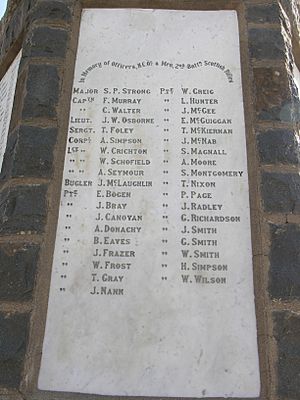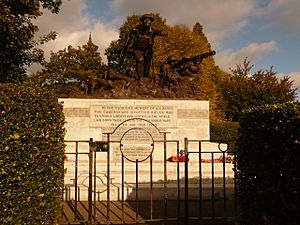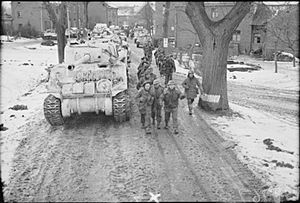Cameronians (Scottish Rifles) facts for kids
Quick facts for kids Cameronians (Scottish Rifles) |
|
|---|---|
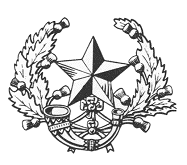
Cap Badge of the Cameronians (Scottish Rifles)
|
|
| Active | 1 July 1881 – 14 May 1968 |
| Country | |
| Branch | |
| Type | Rifles |
| Size | 2 Regular battalions 2 Militia battalions 2 – 4 Territorial and Volunteer battalions Up to 12 hostilities-only battalions |
| Part of | Lowland Brigade |
| Garrison/HQ | Hamilton Barracks, Hamilton (1881–1947) Winston Barracks, Lanark (1947–1964) Glencorse Barracks, Edinburgh (1964–1968) |
| Nickname(s) | (from the 1960s) The Poison Dwarfs. Not a popular nickname as it was derogatory. |
| March | Quick – Within a mile of Edinburgh Toon Slow – The Garb of Old Gaul |
| Commanders | |
| Colonel in Chief | HM King Gustaf VI Adolf |
| Colonel of the Regiment |
Major General Henry Templar Alexander, CB CBE DSO |
| Insignia | |
| Tartan |  |
The Cameronians (Scottish Rifles) was a special type of rifle regiment in the British Army. It was the only Scottish infantry regiment that used rifles. The regiment was created in 1881. This happened when two older regiments joined together: the 26th Cameronian Regiment and the 90th Perthshire Light Infantry.
The Cameronians had a long history, tracing their roots back to 1689. In 1968, the British Army decided to make some changes. Many regiments had to combine with others. However, the Cameronians chose to disband instead of joining another regiment. They were one of only two infantry regiments to make this choice.

Contents
History of the Cameronians
How the Regiment Started
The Cameronians (Scottish Rifles) was formed in 1881. This was part of big changes in the British Army called the Childers Reforms. Two regiments, the 26th Cameronian Regiment and the 90th Perthshire Light Infantry, became one.
After they joined, the 1st Battalion liked to be called "The Cameronians." The 2nd Battalion preferred "The Scottish Rifles." The 2nd Battalion fought in the Battle of Spion Kop in South Africa in 1900. This was during the Second Boer War.
Two other groups, called Militia battalions, were also formed. The 3rd battalion went to South Africa in 1901 for the Boer War. The 4th battalion also went to South Africa in 1900.
In 1908, the army changed again. The regiment then had two Reserve battalions and four Territorial battalions.
Fighting in the First World War
The Cameronians played a big part in the First World War.
Regular Army Battalions
The 1st Battalion arrived in France in August 1914. They served on the Western Front. This battalion famously refused to play football with the enemy on Christmas Day 1914. The 2nd Battalion also arrived in France in November 1914. They also fought on the Western Front.
Territorial Force Battalions
Some of the first part-time units to join the main army were from the Cameronians. The 1/5th Battalion landed in France in November 1914. They fought alongside the 1st Battalion Cameronians. The 1/6th Battalion also served on the Western Front. Later, it joined with the 1/5th to form the 5th/6th Battalion.
The 1/7th and 1/8th Battalions went to Gallipoli in June 1915. After leaving Gallipoli, they moved to Egypt. They fought in the Sinai and Palestine Campaign. In 1918, they moved to the Western Front.
New Army Battalions
Other battalions were formed for the war. The 9th (Service) Battalion arrived in France in May 1915. The 10th (Service) Battalion also landed in France in July 1915. Both fought on the Western Front. The 11th (Service) Battalion went to France in September 1915. But then they sailed to Salonika in November 1915.
Between the World Wars
After the First World War, the 1st Battalion went to Ireland in 1919. This was during the Irish War of Independence. Then, in 1931, they moved to India. The 2nd Battalion went to Mesopotamia in 1919. They then moved to India in 1922.
Fighting in the Second World War
The Cameronians were very active in the Second World War.
The 1st Battalion was in India when the war started. They were sent to Burma in 1942. They fought in the tough Burma Campaign.
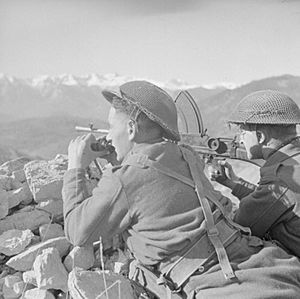
The 2nd Battalion went to France in September 1939. They were part of the British Expeditionary Force. They took part in the Dunkirk evacuation in 1940. Later, they fought in the Allied invasion of Sicily in 1943. They also fought in the Allied invasion of Italy and the Italian Campaign. This included battles at Moro River and Anzio. In 1945, they fought in North West Europe.
The 6th and 7th Battalions were part-time units. They went to France to help cover the retreat of British troops. After the Normandy landings in 1944, they fought in North West Europe.
The 9th Battalion also took part in the Normandy landings in June 1944. They fought in North West Europe, including the Battle of Broekhuizen.
After the Wars
In 1948, the Cameronians, like other regiments, were reduced to one main battalion. The 2nd Battalion was renamed the 1st Battalion. It was sent to Malaya in 1950. This was during the Malayan Emergency.
In the 1960s, some Cameronians were stationed in Germany. A local person called them "poison dwarfs" because of their smaller size and lively behavior. This nickname was not very popular.
In 1968, the Cameronians decided to disband. They did not want to join another regiment. The 1st Battalion was officially disbanded on May 14, 1968. This happened at Douglas Castle in Scotland. The areas where they used to recruit soldiers were taken over by another regiment. The Regimental Headquarters closed in 1987.
Regimental Museum
You can learn more about the Cameronians at their museum. The Cameronians Museum is located inside the Low Parks Museum in Hamilton, South Lanarkshire.
Special Traditions
The Cameronians had some unique traditions:
- Every new soldier received a Bible. This honored Richard Cameron, who the original regiment was named after.
- Soldiers would stand guard with weapons at the church doors during services.
- For formal events, they wore a dark green jacket called a doublet. They also wore trousers with the Douglas tartan pattern.
- They were one of only two regiments in Britain to keep the tall, stiff hat called a shako for full dress after 1878.
Famous Battles and Honours
The regiment earned many battle honours for their bravery. These show where they fought and won. Some of their honours include:
- Early wars: Blenheim, Ramillies, South Africa 1899-1902 (including Relief of Ladysmith)
- The Great War (First World War): Mons, Le Cateau, Somme 1916 '18, Ypres 1917 '18, Gallipoli 1915-16, Palestine 1917-18
- Second World War: Dunkirk 1940, Normandy 1944, Italy 1943-44 (including Anzio), Burma 1942 '44
Important Leaders
The regiment had a special leader called the Colonel-in-Chief. From 1956, this was HM King Gustaf VI Adolf of Sweden.
Memorials to the Cameronians
There are several places that remember the Cameronians:
- On Spion Kop mountain, a memorial lists Cameronian soldiers who died there.
- The Cameronians War Memorial in Kelvingrove Park, Glasgow, shows soldiers with a machine gun. It was unveiled in 1924.
- In Douglas, South Lanarkshire, there is a monument. It remembers both the start of the regiment in 1689 and its disbanding in 1968. There is also a statue of the Earl of Angus, who first raised the regiment.
Notable Former Members
Many brave people served in the Cameronians. One famous person was Sultan Qaboos, who later became the ruler of Oman. He served as a junior officer in the regiment.


